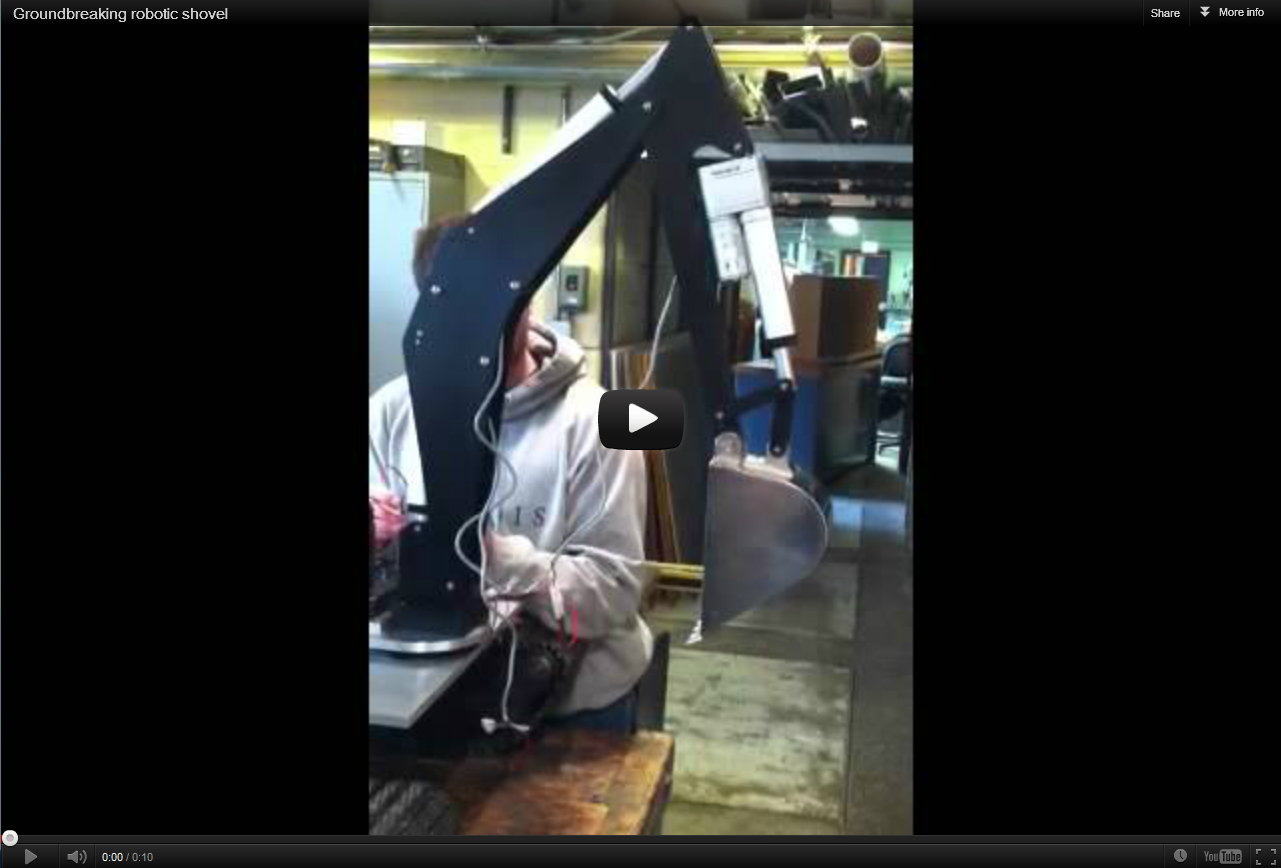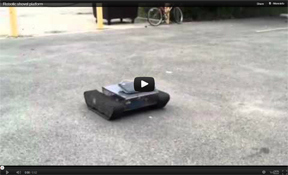Building Campaign Navigation

Investing in the Future
 View our entire construction photo gallery to follow the ECE ILLINOIS Building progress.
View our entire construction photo gallery to follow the ECE ILLINOIS Building progress.
Recent Posts:
- ECE Building includes state-of-the-art music lab
- Donor wall celebrates leadership donors to the Building Campaign for ECE ILLINOIS
- Robotics Laboratory prepares students for the future
- A revamped Digital Signals Lab
- ECE Building grounds’ history with Illinois
- Generating improved power labs
- Low donation funds classroom wing
- Introducing the Open Projects Lab
- $1 million gift makes Srivastava Senior Design Lab possible
THE BUILDING CAMPAIGN FOR ECE ILLINOIS
Autonomous Robotic Shovel Machine
Web-based Controller for Robotic Shovel: A Senior Design Project
A group of students in an ECE Senior Design course designed an Autonomous Robotic Shovel Machine that will be entrenched at the new ECE building site. On November 16 and 17 the robot did some digging on the site of the new ECE building as a robotic groundbreaking event. Video of the event will be posted shortly.
This event was used as a means to honor the many donors to the ECE Building Campaign. A lighted LED board displayed the name of a donor with each scoop of the shovel.
View videos of the various testing stages during building of the Autonomous Robot.
 |
 |
Advanced technology will help make ECE building ‘net zero’
While the stated goal of the new building is to achieve LEED platinum status, the highest rating for a structure’s sustainability and efficiency, plans are already in place to up the ante on that goal.
“We want to achieve net-zero energy output,” said ECE Professor Philip Krein, chair of the ECE Building Committee. “It’s a lofty goal, but we think the technology is there to make this a reality.”
There are several methods that will be used to achieve this goal. On the sustainability side, the design will take advantage of sunlight for lighting within the structure in what is called “passive solar design.” This also reduces summer heat load on the outside walls. Insulation will ensure minimal heat or cooling loss. Chilled beams, an advanced air conditioning system in which cooled or warmed water is passed through ceiling pipes to heat or cool a large building at reduced cost and energy load, will be used throughout much of the new building. Heat-recovery systems will exchange energy as outside air is drawn in.
In addition, solar panels on the roof of the new building as well as on a nearby parking structure will create power that will be dedicated to this new building.
“All of the resources that we’re bringing to bear on this building will make this a living laboratory,” Krein said. “Students will be able to interact with and learn from what we’re putting into this building.”
While construction will soon be under way, private funding is still needed to reach our fundraising goal. To “do your bit,” please visit the Building Campaign for ECE ILLINOIS site.
Interested in making a pledge over five years or want more information? Contact Beth Katsinas, Director of Advancement, at katsinas@illinois.edu or (217) 265-6285.
Groundbreaking Ceremony
The next step in the future of ECE ILLINOIS was taken October 7, 2011, as ground was broken on the site of the new building. Illinois Governor Pat Quinn joined University of Illinois President Michael Hogan, Vice President of the University and Urbana-campus Chancellor Phyllis Wise, College of Engineering Dean Ilesanmi Adesida, and ECE Department Head Andreas Cangellaris to launch the construction of the building.
(Read “Groundbreaking ceremony held for new ECE building“)
“The ECE department has a rich legacy of achievement … and this new facility is an investment that will pave the way for new generations of breakthrough technology,” President Hogan said at the event.
Visit the photo gallery for images of the groundbreaking event.
Media coverage of groundbreaking
- News-Gazette
- WICD (story no longer online)
- WCIA
Release of state funds moves ECE building project forward
The project to construct a new building for the Department of Electrical and Computer Engineering at the University of Illinois at Urbana-Champaign has made a major step forward with the recent release of state funds for the project by Illinois Governor Pat Quinn. The release of the state funds, which was part of a capital bill signed by the governor in 2009, came after the University administration, led by University of Illinois President Michael Hogan, made the case for the importance of this new instructional and research facility to the campus and the state.
Concurrent with the release of state funding, ECE received additional donations that brought the total private support to $37.5 million. Though the building has now entered a stage of preparing for construction, fundraising for the project continues. Private contributions are still being solicited for the remaining $10 million that will complete the funding goal.
If you would like to enable the success of future computer and electrical engineering students at Illinois by contributing to the Building Campaign for ECE ILLINOIS, please use the online tool at www.ece.illinois.edu/buildingcampaign.
Interested in making a pledge over five years or want more information? Contact Beth Katsinas, Director of Advancement, at katsinas@illinois.edu or (217) 265-6285.
Professor Philip Krein at CCNET
Recently, Professor Krein spoke to CCNET, a forum for local citizens and businesspeople to learn about technology and ideas related to sustainability. His remarks provide an excellent overview of the building project so far. Dr. Krein’s talk lasts about 40 minutes and is followed by a question and answer session.
In order for this project to move forward, we depend on the contributions of our friends and alumni. I urge you to donate online at www.ece.illinois.edu/buildingcampaign. If you are interested in making a pledge over five years, contact Beth Katsinas, Director of Advancement, at katsinas@illinois.edu or (217) 265-6285.
Achieving net-zero output for new ECE building
“It’s a big deal, obviously,” explained ECE Professor Philip Krein about the goal for the new ECE building to achieve a net-zero energy output. A big deal, and a goal that requires coordination of numerous internal systems within the new building.
The outcome of this coordinated approach, explained Krein, “is that the energy bill for this building over the course of a year should be zero. It should be producing as much as it uses on the average over the course of a year.”
Certainly, there will be times during peak use, such as during the summer months, when the building would need to take some energy from the University. But that would be offset during the times when the building would create more energy than it uses. Over a full year, these should balance out to essentially zero.
Achieving this goal will require innovative and cutting-edge technologies and designs.
One such technology is the use of a chilled beam system. “This is an advanced version of hot water heat,” explained Krein. Much like a familiar hot water heating system, this system will circulate hot water during the winter to provide heat to the building. What is different from the traditional system is that it will also circulate cooled water during the summer months to provide cooling. This water-based system is more efficient than standard systems that circulate air.
Other strategies will include state-of-the-art technology for the building envelope, including high-efficiency insulation, efficient design of the ventilation components (with heat recovery systems added), use of LED and high-efficiency fluorescent lighting, and extensive passive solar design. For example, architectural elements are designed for shading to reduce solar heat buildup in the summer while also allowing light to enter.
Finally—and perhaps most prominently—solar panels on the roof of the new building as well as on a nearby parking structure will provide electricity for the building. These panels will provide approximately 1,500 kilowatts of power for the building.
“There are other net-zero buildings here and there,” said Krein, “but none are as large as or on the scale of what we’re proposing for the ECE building. This is an ambitious, and I believe ultimately attainable, plan.”
SmithGroup presents 100% drawings
SmithGroup presented the 100% drawings to the department in September. What this means is that the plans for every aspect of the exterior and interior of the building have been put to paper. Four large 48 X 36 inch books ranging in size from 107 to nearly 200 pages give a view into the details that will be the future home of ECE.
On September 24, a meeting was held to carefully review these drawings. Some alterations to these plans may still be made as faculty and staff review these final plans to ensure that such things as the number and position of electrical and computer outlets are sufficient for our current and anticipated future needs.
A small celebration was held following this meeting. Members of the University community gathered together to mingle and express their hopes and expectations for this new ECE building.
Though the celebration was enjoyable, we all know that this building still needs all of ECE’s alumni and friends to do their bit to bring these plans to life. We urge you to be a part of creating the next stage of the legacy of ECE. To contribute to the Building Campaign for ECE ILLINOIS, you can donate online at www.ece.illinois.edu/buildingcampaign. If you would be interested in making a pledge over five years, contact Beth Katsinas, Director of Advancement, at katsinas@illinois.edu or (217) 265-6285.
Center for Light and Plasma Science
When the new ECE building opens, it will house a new science center: The Center for Light and Plasma Science (CLPS).
This new center will bring together scientists and researchers who are studying aspects of and uses for plasma. As the department size has grown over the years, ECE faculty and researchers have had to spread out among the many buildings of the engineering campus. So ECE faculty who study plasma and its uses in power, antennas, atmospheric research, and lasers find themselves in locations quite a distance from one another.
The new center will help change that. ECE Assistant Professor Jonathan Makela, one of the organizers for the new center, said, “Co-locating all ECE plasma researchers in the new ECE building will go a long way in jumpstarting some of the cutting-edge research ideas. … It’s the intellectual collisions of meeting people in the hallway and having our grad students sitting in the same rooms and attending the same seminars where these ideas can rapidly develop.”
Topics to be tackled by the research in CLPS include creating efficient microplasma lighting devices that take advantage of plasma’s unique properties, using plasma for energy conversion and filtering, studying the plasma environment that comprises the Earth’s ionosphere, and using plasma to reconfigure the proprieties of antennas and enable them to radiate at differing frequencies without having to physically change the device.
Board of Trustees approves ECE building design
The University of Illinois Board of Trustees approved the design of the new ECE building at its March 10 meeting at the Illinois Conference Center in Champaign. David King of SmithGroup presented an overview of the new building to the Board.
Following David’s presentation, University of Illinois President Stanley O. Ikenberry said, “This is a very important building for an extremely important program and department. And that aspect alone means that it deserves a lot of attention.”
ECE Department Head Andreas Cangellaris said, “The building will serve as the renewal of Illinois’s promise to continue its role at the epicenter of new waves of technological and economic progress and groundbreaking innovation.”
The Board approval is an important step on the timeline towards the completion of the building. Currently, the building continues to move forward according to schedule. Between now and August detailed construction documents and blueprints will be prepared with a plan to release bids for construction in September 2010, assuming that the necessary funding commitments are in place.
Private support is critical to bring this important project to reality. To keep the project moving forward on schedule, ECE needs pledge commitments. Dozens of alumni and friends have made commitments, but more are needed. Pledges of support can be paid off over time for up to five years. Thank you to all of you who have made your pledge already. To find out more about the building project or to donate, please go to the Web site for the ECE ILLINOIS building campaign.
Architect presents renderings of proposed building design
On September 10, representatives from SmithGroup, the architecture firm that is designing the new ECE building, presented a first look at preliminary images of the proposed new building. The renderings are the result of months of work with the ECE Building Committee and the University. Recently the firm had completed the blocking procedure of trying to determine where the various elements could fit.
Lead architect David King noted that not all of the showpieces for the department were able to fit on the first floor. However, the Instructional Fabrication Lab and labs for ECE 110: Introduction to Electrical and Computer Engineering will be on the first floor, and they will have windows to allow visitors to observe the activities in these exciting labs.
The design envisions a three-story structure and a five-story structure joined by an atrium. The building will contain a 450-seat auditorium for large classes and presentations. There are plans for a green roof and a large array of photovoltaic cells to help power the building. A chilled beam system provides cooling and heating for the taller structure.
Numerous other innovations will be included to make the building as energy efficient as possible. The goal is to achieve near-zero net energy consumption.




